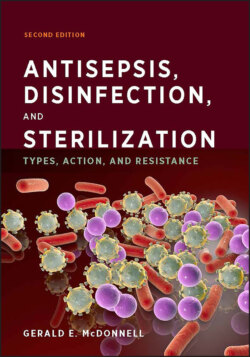Читать книгу Antisepsis, Disinfection, and Sterilization - Gerald E. McDonnell - Страница 41
1.4.9 Water Quality
ОглавлениеWater is an important component of many antiseptic, disinfectant, and sterilization applications. Typical uses of water include:
Biocidal-product formulation (as a solvent)
Biocidal-product dilution on use (e.g., antiseptics and disinfectants)
Cleaning alone or in combination with cleaning formulations prior to disinfection or sterilization
Pharmaceutical-product preparation (e.g., dilution for injection)
Rinsing to remove residuals following cleaning or disinfection
As a disinfectant (moist heat) or sterilization agent (steam)
Humidification as part of sterilization processes (e.g., with ethylene oxide or formaldehyde)
Steam sterilization
TABLE 1.28 Various components of cleaning formulations
| Ingredient | Purpose |
| Solvent, including water | A solvent is a substance (usually liquid) that is capable of dissolving other substances, water being the most common. Solvents are also used for solubilization of various soil components. |
| Emulsifiers, surfactants | Emulsifiers are ingredients (including surfactants) that allow the formation of stable mixtures (emulsions) of water- and oil-soluble ingredients. Surfactants (“surface-acting agents”) can be used as emulsifiers, but also to reduce surface tension, improve the wettability of a surface, disperse contaminants, and inhibit foam formation. |
| Chelating agents or sequestrants | Binding metals (like calcium and magnesium) and inhibiting their precipitation; water softening and prevention of mineral deposition |
| Enzymes | Digestion of soil components, including proteases (protein digestion), lipases (lipid/oil digestion), and amylases (carbohydrate, e.g., starch, digestion) |
| Alkali | pH stabilization; alkalis are used as “builders” to optimize the activities of surfactants, including emulsification of soils and degradation of proteins. |
| Acid | pH stabilization; acids are also used to prevent and remove mineral deposits and for water softening. |
| Dispersants | Suspending solids |
| Corrosion inhibitors | Reducing the corrosion rates and protecting the surfacs of metals |
| Others | Aesthetic qualities, like perfumes and colors, and biocides as preservatives |
In addition to these applications, water itself is a source of microbial contamination (e.g., enteric protozoa, such as Cryptosporidium and Giardia; bacterial pathogens, such as E. coli, Legionella, and Vibrio; and toxins, such as endotoxins), requiring the use of various biocidal products and processes to render it safe for its intended use. The most important of these are the use of halogens (like chlorine and bromine [see section 3.11]), oxidizing agents (like chlorine dioxide and ozone [see section 3.13]), moist heat (boiling and steam distillation [see sections 2.2 and 5.2]), irradiation (such as UV treatment [see section 2.4]), and filtration (see section 2.5).
Water can include various dissolved and suspended contaminants, many of which have negative effects on antiseptic, disinfectant, and sterilization applications (Table 1.29).
Overall, the qualities of water used for particular applications vary, including the following:
Potable water (water that is considered safe for human consumption, which in many countries is tap water)
Pretreated water (e.g., “softened” to remove hardness due to calcium or magnesium ions)
Disinfected (e.g., by UV radiation [see section 2.4])
Filtered to remove gross particulates or pretreated to remove contaminants (e.g., with activated carbon or sodium bisulfite to remove chlorine)
Sterile filtered (to physically remove microorganisms [see section 2.5])
Purified (e.g., by reverse osmosis, deionization, and distillation [see sections 2.5 and 5.2])
TABLE 1.29 Examples of common water contaminants and their effects
| Contaminant | Examples | Concerns |
| Inorganic salts | Hardness (dissolved compounds of calcium and magnesium) | Inhibits activities of cleaners and biocidal products; can also cause the buildup of scaling over time or “spotting” on a surface |
| Heavy metals (metallic elements with high atomic weights, e.g., iron, chromium, copper, and lead) | Can inhibit the activities of cleaners and biocidal products; cause damage to some surfaces (e.g., corrosion); in some cases, toxic and bioaccumulative | |
| Organic matter | Trihalomethanes | Toxic chlorine disinfection byproducts |
| Proteins, lipids, polysaccharides | Can leave harmful residues, including protein toxins and endotoxins (lipopolysaccharide [see section 1.3.7]); can also reduce the effectiveness of biocides | |
| Biocides | Chlorine, bromine | Can cause corrosion and rusting on surfaces (in particular, when carried in steam) |
| Microorganisms | Pseudomonas,Salmonella, and oocysts of Cryptosporidium | Biofilm formation and biofouling; deposition onto surfaces or products and cross-contamination |
| Dissolved gases | CO2, Cl2, and O2 | Can cause corrosion and rusting (in particular, when carried in steam); noncondensable gases, like CO2 and O2, can inhibit the penetration of steam in sterilization processes. |
In some applications, the quality of water required will be specified, including microbiological and chemical limits that should be considered to ensure the safety and effectiveness of biocidal products and processes.
